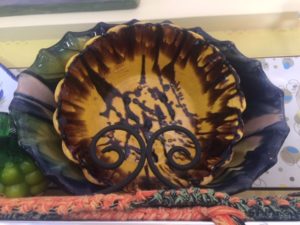 JE found this colorful bowl for $2.50 in a Lompoc thrift store, lucky hunter. We consider this American folk pottery at its best, called redware, with crimped edges, yellow lead glazed, with manganese spatter decoration. You might find it easy to ignore at a thrift store, as you may think it a kid’s piece, or just plain ugly. However, this tells the story of a whole tradition of American kitchenware.
JE found this colorful bowl for $2.50 in a Lompoc thrift store, lucky hunter. We consider this American folk pottery at its best, called redware, with crimped edges, yellow lead glazed, with manganese spatter decoration. You might find it easy to ignore at a thrift store, as you may think it a kid’s piece, or just plain ugly. However, this tells the story of a whole tradition of American kitchenware.
First a caution: do not use this for food, JE, because the lead glaze and manganese decoration are toxic.
Decoration, you say? Are those drips really decoration? Yes. A whole tradition of dripping a glaze became known as spatterware, and although we don’t collected this on THIS coast, the East Coast collectors snap this up. Prized for its dark deep purple to brown glow, craftsmen often used Manganese in early American pottery. The glow results from the metallic sheen that reflects the light. Think of a candle lit kitchen and you see the piece as not quite so ugly. The yellow glaze itself is also toxic due to lead glaze, which also glows with a metallic sheen.
Today the EPA warns not to use ceramics glazed with lead because any amount of lead is a toxin.
Why did our American ancestors use lead?
First, although we knew potters often died early or went crazy, no one made the correlation between the utilitarian glaze and those ‘mad potters.’ A lead based glaze is impervious to foods with an acid content, for one. In addition, we consider the surface shiny, pretty, and it repels water. And no other efficient glaze existed for making low fired, inexpensive clay kitchen pieces.
The potter glazed a piece like this before it entered the kiln to bake. Lead is a ‘melter’ in ceramic glazes and colors, which meant that a potter need not have an expensive, high temperature kiln. JE’s piece is “low fired” terracotta, impossible to create in an inexpensive, low temperature kiln without lead in the glaze. A typical low fired kiln put out 1,700-1,800 degrees Fahrenheit, and if a potter used the readily available local clay, any temperature higher than that melted the clay. So you see why they used lead in abundance. Of course for use in the kitchen, terracotta must be glazed to resist liquids. Colonial potters found this a distinct advantage for making utilitarian household objects of redware, of America terracotta, local clay. So cheap to make, necessary to the kitchen, and owned by just about all American households in the 18th and early 19th century.
Cheap to create? Yes!
An American colonial potter only needed a wheel, local clay, and lead oxide, which the potter melted from the lead foil wrapper than contained imported tea. The kiln was a simple stone or brick building banded with iron straps. Housewives showed up from miles around when the potter cooked a batch.
Collectors call JE’s piece “hollowware” because potters created these pieces to contain something. They threw pieces on a potter’s wheel, or molded, such as a dish, plate or bowl form. They they rolled clay with a rolling pin and formed over a wooden mold, and trimmed. The edges, as in JE’s bowl, they then coggled (fluted or pinched) because a fluted rim showed less flake size if anything chipped the rim. Makes sense!
Less than one percent of all redware was signed, says the website of a major dealer of the wares, Greg Kramer, of Greg K. Kramer & Co. in Robesonia, Pennsylvania. He writes that we associate the colors of the decoration with the region. The yellow glaze with brown splotches consumers considered desirable so the colors, associated with the Shenandoah Valley, became the rage in the early 19th century. Tastes have changed.
I commend JE because a bowl like this is easy to miss in a thrift store as nothing special. The bowl is worth $350, but could be worth more to a collector. Great pieces such as figures of dogs and lions and toys such as whistles of 18th and 19th century redware sell for $10,000-$50,000. I suggest JE send a picture to Mr Kramer and see what he might buy it for. You got lucky in Lompoc, JE. Good eye! As we say in the business.
Pingback: Raise a Toast to this Ale Mug - Elizabeth Appraisals